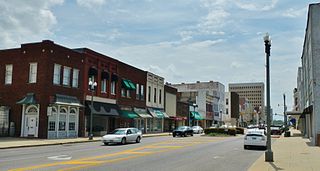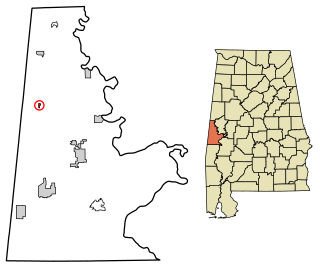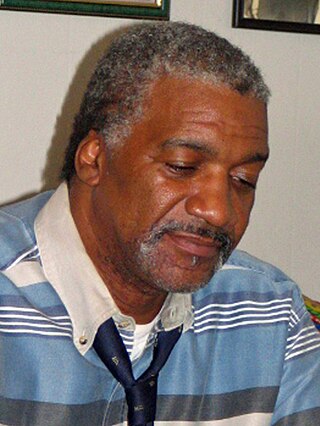Related Research Articles

Polychlorinated biphenyls (PCBs) are highly carcinogenic chemical compounds, formerly used in industrial and consumer products, whose production was banned in the United States by the Toxic Substances Control Act in 1976 and internationally by the Stockholm Convention on Persistent Organic Pollutants in 2001.
The Monsanto Company was an American agrochemical and agricultural biotechnology corporation founded in 1901 and headquartered in Creve Coeur, Missouri. Monsanto's best-known product is Roundup, a glyphosate-based herbicide, developed in the 1970s. Later, the company became a major producer of genetically engineered crops. In 2018, the company ranked 199th on the Fortune 500 of the largest United States corporations by revenue.

Anniston is the county seat of Calhoun County in Alabama, United States, and is one of two urban centers/principal cities of and included in the Anniston-Oxford Metropolitan Statistical Area. As of the 2010 census, the population of the city was 23,106. According to 2019 Census estimates, the city had a population of 21,287. Named "The Model City" by Atlanta newspaperman Henry W. Grady for its careful planning in the late 19th century, the city is situated on the slope of Blue Mountain.

Emelle is a town in Sumter County, Alabama, United States. It was named after the daughters of the man who donated the land for the town. The town was started in the 19th century but not incorporated until 1981. The daughters of the man who donated were named Emma Dial and Ella Dial, so he combined the two names to create Emelle. Emelle was famous for its great cotton. The first mayor of Emelle was James Dailey. He served two terms. The current mayor is Roy Willingham Sr. The population was 32 at the 2020 census.

Love Canal is a neighborhood in Niagara Falls, New York, United States, infamous as the location of a 0.28 km2 (0.11 sq mi) landfill that became the site of an environmental disaster discovered in 1977. Decades of dumping toxic chemicals killed residents and harmed the health of hundreds, often profoundly. The area was cleaned up over the course of 21 years in a Superfund operation.

Solutia Inc. was an American manufacturer of materials and specialty chemicals including polyvinyl butyral (PVB), ethylene vinyl acetate (EVA), and thermoplastic polyurethane (TPU) interlayers for laminated glass, aftermarket window films, protective barrier and conductive films, and rubber processing chemicals. The company was formed on September 1, 1997, as a divestiture of the Monsanto Company chemical business. In July 2012, the company was acquired by Eastman Chemical Company.
The Michigan Farm Bureau was founded on the campus of Michigan State University in 1919. The organization's primary goal is to promote and represent the interests of its agricultural members within the state of Michigan.

Munisport Landfill is a closed landfill located in North Miami, Florida adjacent to a low-income community, a regional campus of Florida International University, Oleta River State Park, and estuarine Biscayne Bay.

Fort McClellan, originally Camp McClellan, is a decommissioned United States Army post located adjacent to the city of Anniston, Alabama. During World War II, it was one of the largest U.S. Army installations, training an estimated half-million troops. After the war it became the home of the Military Police Corps, the Chemical Corps and the Women's Army Corps. From 1975 and until it was closed in 1999, Fort McClellan was home of the Military Police Corps and the One Station Unit Training (OSUT) Military Police School. Also after World War II and until it was closed in 1999, it was home of the Chemical Corps School, which trained soldiers in chemical warfare. In 1988, Fort McClellan was used as an alternate training academy for the United States Border Patrol. Before its closure by the Base Realignment and Closure commission (BRAC), the post employed about 10,000 military personnel and about 1,500 civilians. It underwent unexploded ordnance (UXO) clean up from 2003 to 2014. Since 2010, about 3,000 acres of the post's brownfield land have been redeveloped as a mixed-use community. The portion of the post which has not been redeveloped is currently owned by the Alabama Army National Guard and is used as a training facility for units from all across the state. Fort McClellan also still houses an operational OCS, Officer Candidate School, for enlisted soldiers looking to earn their commission.

Warren County PCB Landfill was a PCB landfill located in Warren County, North Carolina, near the community of Afton south of Warrenton. The landfill was created in 1982 by the State of North Carolina as a place to dump contaminated soil as result of an illegal PCB dumping incident. The site, which is about 150 acres (0.61 km2), was extremely controversial and led to years of lawsuits. Warren County was one of the first cases of environmental justice in the United States and set a legal precedent for other environmental justice cases. The site was approximately three miles south of Warrenton. The State of North Carolina owned about 19 acres (77,000 m2) of the tract where the landfill was located, and Warren County owned the surrounding acreage around the borders.
The Anniston–Oxford metropolitan statistical area is the second-most populated metropolitan area in Northeast Alabama, behind Huntsville. At the 2000 census, it had a population of 112,249. The MSA is anchored by significant jobs at Jacksonville State University, the Northeast Alabama Regional Medical Center, Stringfellow Hospital, the Anniston Army Depot, and the Department of Homeland Security at McClellan. McClellan has transitioned from being a closed military base, to becoming the home of hundreds of residents, new retail growth such as a Lowe's Home Improvement Store, and now more than 3,000 jobs spread out over more than 20 employers. Anniston remains strong in health care, legal, financial services and manufacturing. Oxford, with Interstate 20 running right through it, has developed a number of retail and restaurant establishments including the Oxford Exchange which is anchored by Target.

David A. Baker is an American activist. A former union organizer, Baker is the founder and director of Community Against Pollution.
Brofiscin Quarry, Groes Faen is a disused limestone quarry in Groes-faen, near Llantrisant in South Wales. It was used for about seven years for the dumping of toxic waste including polychlorinated biphenyls (PCBs) and was capped in 2011. Some 72 000m3 / 80 000 tonnes of material was dumped here. Prior to its remediation, The Guardian described the site as "one of the most contaminated places in Britain." The level of pollution is such that it featured in an international conference discussing remediation of contaminated land. These events were described by The Ecologist magazine as "one of the biggest environmental crimes to have occurred in the UK". and the key witness at an Environmental Agency inquiry on 2006 ended up needing to live under police protection. The company using this disposal site also used the nearby Maendy Quarry.

The March Against Monsanto was an international grassroots movement and protest against Monsanto, a producer of genetically modified organisms (GMOs) and Roundup, a glyphosate-based herbicide. The movement was founded by Tami Canal in response to the failure of California Proposition 37, a ballot initiative which would have required labeling food products made from GMOs. Advocates support mandatory labeling laws for food made from GMOs.

Groundwater pollution occurs when pollutants are released to the ground and make their way into groundwater. This type of water pollution can also occur naturally due to the presence of a minor and unwanted constituent, contaminant, or impurity in the groundwater, in which case it is more likely referred to as contamination rather than pollution. Groundwater pollution can occur from on-site sanitation systems, landfill leachate, effluent from wastewater treatment plants, leaking sewers, petrol filling stations, hydraulic fracturing (fracking) or from over application of fertilizers in agriculture. Pollution can also occur from naturally occurring contaminants, such as arsenic or fluoride. Using polluted groundwater causes hazards to public health through poisoning or the spread of disease.
Monsanto was involved in several high-profile lawsuits, as both plaintiff and defendant. It had been defendant in a number of lawsuits over health and environmental issues related to its products. Monsanto also made frequent use of the courts to defend its patents, particularly in the area of agricultural biotechnology. Bayer acquired Monsanto in 2018, and the company has since been involved in litigation related to ex-Monsanto products such as glyphosate, PCBs and dicamba. In 2020 it paid over $10 billion to settle lawsuits involving the glyphosate based herbicide Roundup.
The Swann Chemical Company was an American chemical company started by Theodore Swann, described by one historian as "a flamboyant Birmingham mogul and New South industrialist." Swann Chemical first operated a chemical manufacturing plant in Anniston, Alabama where PCBs were first made on an industrial scale after development of a new process under leadership of Theodore Swann. The plant was later bought by Monsanto Industrial Chemicals Co. in 1935. The plant, just west of Anniston, had around 1,000 employees.
Theodore Swann was an American industrialist and early leader of the chemical industry. He was described by one historian as "a flamboyant Birmingham mogul and New South industrialist."
Environmental issues in Toronto encompasses all those concerns and opportunities presented by the environment of Toronto. Many are harmful effects, such as the pollution of air and water, while others are factors influenced by urban infrastructures such as highways and public transportation services. As a result of the city's large population, substantial waste is produced annually.
Emmell's Septic Landfill (ESL) is located at 128 Zurich Ave, Galloway Township, New Jersey and takes up about 38 acres of space. The landfill was in operation from 1967 until 1979. ESL disposed of liquid and solid waste including many chemicals such as volatile organic compounds (VOCs), Polychlorinated Biphenyls (PCBs), Trichloroethene and Vinyl chloride which all had their own effect on the environment and community. These chemicals affected the groundwater required millions of dollars to reconstruct the groundwater pathways and provide clean water to residents. The landfill holds a Hazardous Ranking Score of a 50/100, qualifying for the Superfund National Priority List. In August 1999, the state acknowledged the site's contamination and held town meetings and provided research upon the site such as groundwater samples. In July 1997, a sitewide investigation was called upon by the United States Environmental Protection Agency. In total the clean up was estimated to cost $5 million to fund this superfund site, and a grant of $3.9 million was given by the Federal Government under the Recovery Act Funding (Previti). Today, the project is still ongoing however, greatly improved since the landfill was discovered.
References
- 1 2 Chemical Body Burden Handbook Case Study Archived 2011-02-21 at the Wayback Machine
- ↑ The People's Voice Weekly Potential Contamination, Hazards Associated With Proposed Landfill, Central Focus of Meriwether NAACP Meeting
- ↑ Salem News Ugly Truth About the American Cancer Society